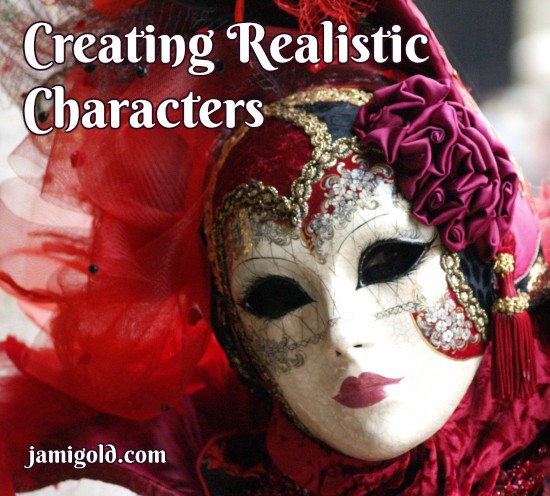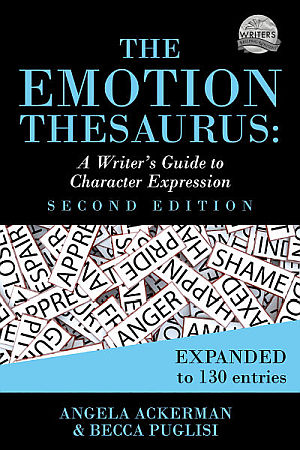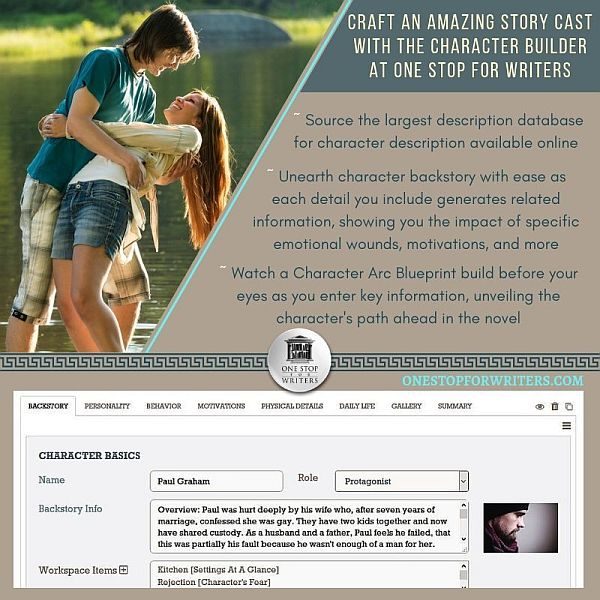Struggle to Write Characters? Here’s Help!

As writers, we have to make our characters seem real to readers. Let’s stop for a minute and think about how amazing that concept is…
We’re taking an idea from our heads — nothing tangible, nothing specific — and giving readers something that feels real. We’re giving them characters…people, really, that they wouldn’t be surprised to meet on the street. We’re giving them characters to look up to, friends to connect to, characters they can learn from, book boyfriends to swoon over, etc.
Almost every reader has a story to share about a character that felt real enough to them that they’d like to meet, talk to, and/or be friends with them. When we think about the character-creation process from that perspective, what we do is pretty amazing. *grin*
But it’s often not easy. So today I’m sharing two resources that can help us create characters that seem real.
Resource #1:
Release Day! The Emotion Thesaurus Second Edition
If you’re not familiar with The Emotion Thesaurus by Angela Ackerman and Becca Puglisi of Writers Helping Writers, it lists physical, internal, and mental responses we can use with our characters for different emotions. In other words, it’s a resource to help us make our characters seem real by showing realistic emotions, even for our non-point-of-view characters.
Struggle to write characters that seem real? Here are two resources to help! Click To TweetYou may have heard me talk about The Emotion Thesaurus before, or even have a copy. The original’s lists of body language, thoughts, and visceral sensations for 75 unique emotions made brainstorming character expressions and reactions so much easier that it quickly became a bestseller.
Now, there’s a bigger, better second edition. Angela and Becca have added 55 new emotions, such as Euphoria, Vindicated, and Schadenfreude.
What’s New in the Second Edition?
Like many writers, I have the original ET, so that of course prompts the question: If I have the first edition already, do I need the second edition?
The second edition is almost twice the size as the original, so there’s a lot of new information. For all the details, check out my post from last month with the 6 ways the Second Edition is new and improved:
- the aforementioned 55 new emotion entries
- expanded details for all 130 entries
- character research advice
- emotion in dialogue tips
- emotion and subtext advice
- brainstorming for emotion tips
Personally, I think it’s so worth it that I have copies in two different formats. *grin* I know many like craft books in print, but I’ve also liked the PDF version of this book for on-screen use while I’m writing. (Also note that the ebook and PDF versions include links between emotions, making it easier to explore our options.)
Want This Resource? Grab a Copy!
 The bestselling Emotion Thesaurus has been hailed as “the gold standard for writers” and credited with transforming how writers craft emotion. If you need inspiration for creating characters’ emotional responses that are personalized and evocative, this ultimate show-don’t-tell guide for emotion can help.
The bestselling Emotion Thesaurus has been hailed as “the gold standard for writers” and credited with transforming how writers craft emotion. If you need inspiration for creating characters’ emotional responses that are personalized and evocative, this ultimate show-don’t-tell guide for emotion can help.
It includes:
- Body language cues, thoughts, and visceral responses for 130 emotions that cover a range of intensity from mild to severe, providing innumerable options for individualizing a character’s reactions
- A breakdown of the biggest emotion-related writing problems and how to overcome them
- Advice on what should be done before drafting to make sure your characters’ emotions will be realistic and consistent
- Instruction for how to show hidden feelings and emotional subtext through dialogue and nonverbal cues
- And much more!
Amazon | Apple | Barnes & Noble | Chapters/Indigo | Kobo | Indiebound | Book Depository | Smashwords | Gumroad-PDF
Resource #2:
Character Builder on One Stop for Writers
Every time I turn around, the very same Angela and Becca as behind The Emotion Thesaurus are adding new tools to their One Stop for Writers website.
Plotter or pantser—no matter how we write, the new Character Builder tool can help... Click To TweetFor many years, One Stop for Writers was an online version of all their thesaurus collections and tools—which is great! But they’ve been slowly adding more complex tools, such as their Story Maps, Scene Maps, Timelines, and Worldbuilding Survey…which is just awesome. *grin*
Then last week, they released their biggest One Stop development yet, a character-development tool! This resource makes the character-creation process organized, allowing us to develop deep, realistic characters in a fraction of the time.
I’ll let Angela and Becca explain the details:
The hyper-intelligent Character Builder is integrated with our description database, generators, and behavioral lists. This means as you work on your character, the tool will prompt you with specific options and choices that will be the best fit for them, helping you to build your seedling ideas into a full-blooded, three-dimensional character.
Whether you’re a plotter or a pantser, you can use the Character Builder to:
- Explore a character, their backstory, personality, behavior, motivations, physical features, and more
- Gain stronger characterization-building skills through a comprehensive set of tutorials
- Build a personalized character arc blueprint that outlines how the character’s difficult history will present challenges on the path to their goal and defines the growth they must attain to achieve success
- Print profiles or export them to your favorite writing software for easy access
How Can We Use the Character Builder? Part One
There’s no one element of a character that has to be a foundation upon which we build everything else (no matter the bazillion blog posts that might tell us otherwise). We can build in many different directions and still end up with a finished character arc.
Remember that a character arc is about their internal journey:
- What do they learn about themselves or the world?
- What are they able to do at the end of the story that they couldn’t do before?
- How do their beliefs about themselves or the world change?
To create realistic characters, we need to understand what makes them tick, what their path is through the story. The Character Builder helps us discover, build, and organize information—no matter our starting point—which is why it’s helpful for any type of writer, including those of us who write by the seat of our pants.
For example, we could start with…
- an understanding of the ending (how they change, what they learn, what goal they reach, etc.) and work backward to develop a contrast from beginning to end
- a theme we want to develop and figure out what we want them to learn to illustrate that theme
- a scene that demonstrates a turning point choice they make and figure out what motivation would lead to that choice
- an understanding of the backstory wound and develop the false belief and fear that would result from it
- a fear or false belief and ideas for how they might overcome it
- a character flaw/weakness and brainstorm how they might move forward
How Can We Use the Character Builder? Part Two
Take a minute to join Becca on a tour and see how any of those starting-point approaches above can work with the amazing new Character Builder tool:
As Becca mentions, we can use this tool to start building our character from many different points. Maybe for our starting point, we have an idea of their…:
- backstory (wound, fears, lie, and secrets)
- personality (positive and negative character traits)
- tangible details (behavior, physical details, and daily life)
- motivations (story goals for outer motivation and character arc for inner motivation)
- emotional shielding (self-protection and avoidance)
- fatal flaw (what do they need to change?)
How Can We Use the Character Builder? Part Three
For more insights into the Character Builder, check out these posts from Angela with additional tips in how we can use this amazing tool:
- two examples of developing characters from different starting points (backstory wound and outer motivation)
- three ways the Character Builder can help writers
- insight into how different types of writers can all use the tool (and a bonus example of how the tool connects the dots between different character elements, like inner motivation and fatal flaw)
Personally, I can’t wait to dig in and play with this tool. I love character arc development, so this looks downright fun. *grin*
Bonus Help for Writers
One Stop for Writers Sale!
To make it easy for writers to play with the new Character Builder, until the end of February, Angela and Becca are offering a sale on their One Stop for Writers site. Get 75% off their 1-month plan.
To redeem:
- Register and then click on the confirmation link that they’ll email to you. (If you’ve previously registered, just sign in.)
- Go to My Subscription (under the ACCOUNT tab)
- Enter the code: CHARACTER (no spaces) into the coupon code box and activate it, following the prompts
- Attach a credit card
- Select the 1-month plan
Note: The 75% discount will be applied to your first invoice only. Cancel any time. Their pricing plans are here.
$500 Giveaway Alert!
 Wish you could attend a free writing retreat, go to a conference, snag a seat at a workshop, or have your professional membership to a writing organization paid for? Of course you do!
Wish you could attend a free writing retreat, go to a conference, snag a seat at a workshop, or have your professional membership to a writing organization paid for? Of course you do!
At Writers Helping Writers, one lucky winner will get one of the above, up to a $500 US value!
This is the giveaway of a lifetime, so hurry over to enter!
What makes characters feel real to you as a reader? Do you struggle with writing realistic characters? What tools have helped you develop characters? Have you tried either of these tools before? Are you as excited as I am for the new Character Builder? *smile*
Pin It

Jami, where do I even begin? You are so unbelievably wonderful to sing our praises like this and profile not only our book, but our new Character Builder at One Stop. I am hugging you through the screen. Thank you so, so, so much!
Thanks Jami, always good to have resources. I am currently learning about screenplays and storyboarding to make short films in college. Character and backstory are important there too, but even more than in books, the message is not to bore the reader with backstory and exposition. A throwaway line, an attitude, a lack of something, can all denote character. A photo of a football team on the wall can show the sports involvement. Fascinating stuff and I hope this will make my books better too.
I’ve been struggling with a character for several months and I’m ready to give up on him. I’ve tried all the tools but he still refuses to come out and play. I do own the first edition of the CT and find it useful to spark my thoughts about emotions while writing but haven’t used it to create a character.
[…] https://jamigold.com/2019/02/struggle-to-write-characters-heres-help/ “As writers, we have to make our characters seem real to readers. Let’s stop for a minute and […]
One thing I learned to do was watch how the person talks. Hard lesson for me to learn since I tend to write like I think. An example is the Character I call Zorro. He’s rather brain damaged from to many drugs, but will drift from Spanish to English in the space of a sentence. Sometimes he sounds highly intelligent, others a couple dopehead. Also, he knows he has a problem so he tends to be rather quiet. He also has certain mannerisms reflecting respect. While he has little respect for most cops, he has boatloads of respect for RJ and Will, and almost always calls them Mr. Madril of Mr. Diaz.